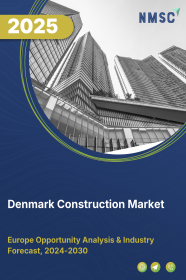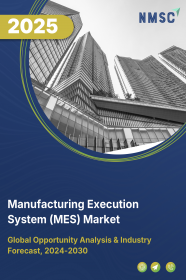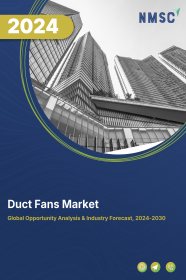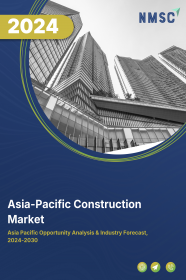
Denmark Construction Market by Type (Renovation and New Construction), and by Sector (Real Estate, Infrastructure, and Industrial)–Opportunity Analysis and Industry Forecast, 2024–2030
Industry: Construction & Manufacturing | Publish Date: 04-Apr-2025 | No of Pages: 143 | No. of Tables: 108 | No. of Figures: 53 | Format: PDF | Report Code : CM2202
US Tariff Impact on Denmark Construction Market
Trump Tariffs Are Reshaping Global Business
Denmark Construction Market Overview
The Denmark Construction Market size was valued at USD 48.87 billion in 2023, and is predicted to reach USD 65.86 billion by 2030, at a CAGR of 6.1% from 2024 to 2030.
The construction market, often referred to as infrastructure, is a crucial contributor to the economy. It manages the entire process from initial planning to ongoing maintenance of various physical structures, including infrastructure, buildings, and facilities. This sector covers a broad range of projects, including residential, commercial, industrial, civil engineering, and institutional infrastructure developments.
It involves collaboration among multiple stakeholders, such as architects, engineers, contractors, suppliers, developers, investors, and government agencies. The industry is positioned for growth, driven by a heightened focus on environmentally sustainable practices, incorporating green building materials and energy-efficient designs. Additionally, factors like rising per capita income in emerging economies and low-interest rates in developed nations are expected to further stimulate the expansion of the infrastructure market.
Government Initiatives Fuel Expansion in Denmark Construction Market
Denmark's construction sector is currently undergoing substantial expansion, driven by a surge in infrastructure activities and government-led initiatives. In July 2021, the Danish government unveiled a comprehensive plan to allocate USD 24.35 billion towards infrastructure development. This significant investment aims to upgrade and modernize the country's transportation systems.
Growth in Underground Construction Projects Boosts Market
The construction market in Denmark is also experiencing remarkable growth due to the increasing number of underground infrastructure projects. Notable projects initiated in 2022 include the Nordhavn Tunnel, the Fehmarn Belt Fixed Link, the Marseilles Tunnel, and the Storstrom Bridge. These major undertakings play a crucial role in the growth and expansion of the market, highlighting the significant potential and progress within the industry.
Regulatory Complexities Impede Growth in the Construction Market
The construction market grapples with significant challenges arising from stringent regulatory frameworks. Infrastructure ventures face obstacles due to the intricate network of government regulations and permitting processes.
Infrastructure projects typically entail securing numerous permits and approvals from governmental bodies at local, regional, and national levels. These permissions encompass zoning regulations, environmental assessments, compliance with building codes, safety standards, and various regulatory requirements.
Lengthy permit acquisition processes, bureaucratic inefficiencies, and regulatory disparities among jurisdictions can significantly prolong project timelines and inflate costs. Additionally, fluctuations in regulations or unexpected policy changes can disrupt ongoing projects and discourage potential investments. For instance, the United States Environmental Protection Agency (EPA) oversees various aspects of the infrastructure sector, including air quality, lead management, waste disposal, and water regulations.
The EPA's compliance assistance centers offer resources to facilitate environmental compliance during demolition activities, the recycling of infrastructure materials, and the proper disposal of refrigeration and air-conditioning equipment.
Integration of Digitalization and BIM Presents Lucrative Opportunity for Market Expansion
The construction market is undergoing a significant transformation with the integration of digitalization and the adoption of Building Information Modeling (BIM), leveraging advanced technologies to enhance efficiency, accuracy, and collaboration across various projects. BIM, an advanced 3D modeling tool, empowers stakeholders to generate and oversee digital renditions of structures and infrastructure, facilitating improved coordination and communication among project teams.
For example, in September 2022, the National Institute of Building Sciences (NIBS) launched the Denmark National Building Information Management (BIM) Program, aiming to revolutionize the infrastructure industry and achieve unprecedented levels of industrial efficiency through digitalization. This initiative addresses the insufficient degree of digitalization within the Denmark infrastructure sector, which impedes the evolution of lifecycle work processes to become more efficient, cost-effective, resilient, and safer for infrastructure and maintenance.
Competitive Landscape
The market players operating in the Denmark infrastructure industry Per Aarsleff A/S,Skanska Denmark, Ramboll, MT Højgaard, LHG.dk, HusCompagniet, Scandinavian Energy Contractors A/S, Vinci SA, ZÜBLIN, HPH Totalbyg A/S, Helian, S. Petterson & Co. ApS, HusCompagniet A/S, Lind & Risør A/S, Edzub Construction and Engineering, and others.
Denmark Construction Market Key Segments
By Type
-
Renovation
-
New Construction
By Sector
-
Real Estate
-
Residential
-
Affordable
-
Luxury
-
-
Commercial
-
Retail Buildings
-
Office Buildings
-
Hospitality
-
Healthcare Facilities
-
Educational Institutes
-
Entertainment Ventures
-
-
-
Infrastructure
-
Transportation
-
Airport
-
Port
-
Rail
-
Road
-
-
Water and Wastewater
-
Energy
-
Telecommunication
-
-
Industrial
-
Manufacturing Plant
-
Warehouses
-
Power Plants
-
Oil Refineries
-
Chemical Plants
-
Key players
-
Per Aarsleff A/S
-
Skanska Denmark
-
Ramboll
-
MT Højgaard
-
LHG.dk
-
HusCompagniet
-
Scandinavian Energy Contractors A/S
-
Vinci SA
-
ZÜBLIN
-
HPH Totalbyg A/S
-
Helian
-
S. Petterson & Co. ApS
-
HusCompagniet A/S
-
Lind & Risør A/S
-
Edzub Construction and Engineering
REPORT SCOPE AND SEGMENTATION:
|
Parameters |
Details |
|
Market Size in 2023 |
USD 48.87 Billion |
|
Revenue Forecast in 2030 |
USD 65.86 Billion |
|
Growth Rate |
CAGR of 6.1% from 2024 to 2030 |
|
Analysis Period |
2023–2030 |
|
Base Year Considered |
2023 |
|
Forecast Period |
2024–2030 |
|
Market Size Estimation |
Billion (USD) |
|
Growth Factors |
|
|
Companies Profiled |
10 |
|
Market Share |
Available for 10 companies |
|
Customization Scope |
Free customization (equivalent up to 80 working hours of analysts) after purchase. Addition or alteration to country, regional, and segment scope. |
|
Pricing and Purchase Options |
Avail customized purchase options to meet your exact research needs. |

















 Speak to Our Analyst
Speak to Our Analyst

















